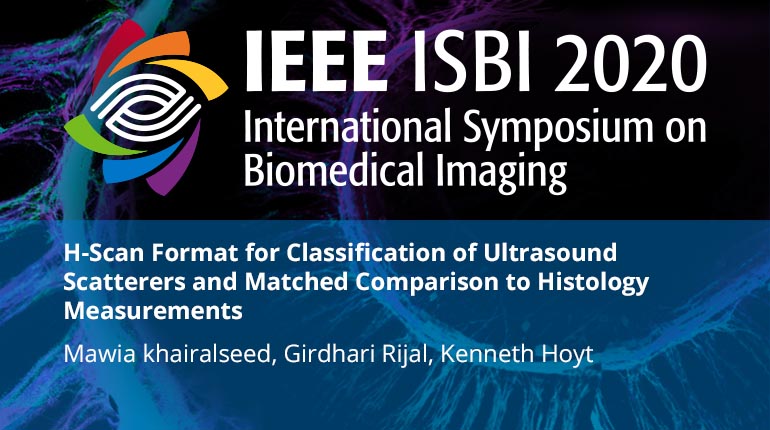
Already purchased this program?
Login to View
This video program is a part of the Premium package:
H-Scan Format for Classification of Ultrasound Scatterers and Matched Comparison to Histology Measurements
- IEEE MemberUS $11.00
- Society MemberUS $0.00
- IEEE Student MemberUS $11.00
- Non-IEEE MemberUS $15.00
H-Scan Format for Classification of Ultrasound Scatterers and Matched Comparison to Histology Measurements
H-scan imaging is a new ultrasound (US) technique used to visualize the relative size of acoustic scatterers. The purpose of this study was to evaluate the sensitivity of H-scan US imaging to scatterer size and comparison to histological sections of tumor tissue. Image data was acquired using a programmable US scanner (Vantage 256, Verasonics Inc) equipped with a 256-element L22-8v capacitive micromachined ultrasonic transducer (CMUT, Kolo Medical). To generate the H-scan US image, three parallel convolution filters were applied to the radiofrequency (RF) data sequences to measure the relative strength of the backscattered US signals. H-scan US imaging was used to image a gelatin-based heterogenous phantom and breast tumor-bearing mice (N = 4). Excised tumor tissue underwent histologic processing and the cells were segmented to compute physical size measurements at the cellular level followed by spatial correlation with H-scan US image features. The in vitro results show that there was an improvement in the contrast-to-noise ratio (CNR) of 44.1% for H-scan compared to B-scan US imaging. Preliminary animal studies revealed there was a statistically significant relationship between H-scan US and physical size measures at the cell level (R2 > 0.95, p
H-scan imaging is a new ultrasound (US) technique used to visualize the relative size of acoustic scatterers. The purpose of this study was to evaluate the sensitivity of H-scan US imaging to scatterer size and comparison to histological sections of tumor tissue. Image data was acquired using a programmable US scanner (Vantage 256, Verasonics Inc) equipped with a 256-element L22-8v capacitive micromachined ultrasonic transducer (CMUT, Kolo Medical). To generate the H-scan US image, three parallel convolution filters were applied to the radiofrequency (RF) data sequences to measure the relative strength of the backscattered US signals. H-scan US imaging was used to image a gelatin-based heterogenous phantom and breast tumor-bearing mice (N = 4). Excised tumor tissue underwent histologic processing and the cells were segmented to compute physical size measurements at the cellular level followed by spatial correlation with H-scan US image features. The in vitro results show that there was an improvement in the contrast-to-noise ratio (CNR) of 44.1% for H-scan compared to B-scan US imaging. Preliminary animal studies revealed there was a statistically significant relationship between H-scan US and physical size measures at the cell level (R2 > 0.95, p
 Cart
Cart Create Account
Create Account Sign In
Sign In





